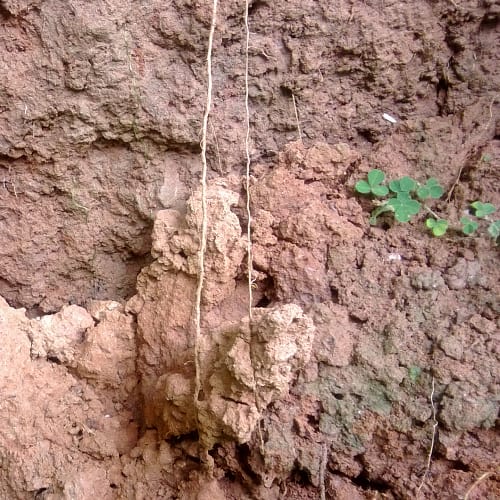
Markedly fine substrates are some of the hardest types of soil to work with in a home garden. Apart from having poor drainage properties, they may be unable to provide an oxygenated environment for the efficient circulation of nutrients. Thus, many sensitive plants may struggle to survive when they are rooted in uniformly packed soil. Anoxia and prolonged water retention are major challenges that usually leave fine substrates bare and seemingly inhospitable to plants.
In wet, clay soil, the likelihood of root decay is heightened as moisture tends to become trapped in the compact particles. While many temperate herbs are unlikely to thrive in these poor conditions, there are some hardy trees that are especially suited to them. With adaptations for remaining anchored and for obtaining atmospheric oxygen, a few of these can even tolerate periodic floods.
The trickiest clay-based soils are those that remain waterlogged due to either their location in a garden or the presence of a permanent source of water. Zones with this type of substrate can be converted into rain gardens or re-conditioned with the help of trees. As tree roots expand and become well-established in the packed soil, they help aerate the substrate and diversify its organic contents.
1) Bald cypress (Taxodium distichum)

A remarkably adaptable species, the bald cypress is able to thrive in a wide range of soil types. Its roots can tolerate being partly or fully submerged in water, making it a common species in swampy zones throughout its native range. The horizontal roots of this tree’s shallow root system are equipped with pneumatophores, which are specialized organs for air transport and stability.
Valued for their rot-resistant hardwood, bald cypress trees play extremely important roles in wetland systems. Apart from absorbing floodwaters and stabilizing the substrate, this phenomenal tree serves as nesting and breeding grounds for birds, fish, and amphibians. Its submerged structures, which can take up a spread of about 6 feet (1.8 meters), protect many aquatic animals.
As bald cypress trees are able to grow as tall as 120 feet (36.6 meters), they are often referred to as the “giants” of swamp systems. Their presence can significantly influence ecological structure in permanently wet stands. Hardy to USDA zones 4 – 10, they may struggle to colonize well-draining substrates where other trees may compete with their seedlings for nutrients and space.
2) River birch (Betula nigra)
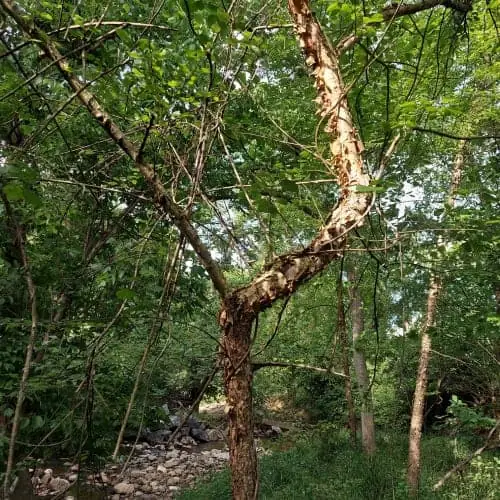
Also called the black birch or water birch, B. nigra is a fantastic tree for rain gardens and naturally moistened shorelines. Its roots, particularly the segments situated close to the soil surface, are known for being highly absorptive. This heat-tolerant tree is found in swampy areas and floodplains, so it is usually able to thrive in the wet and compact substrates of rain gardens.
The root system of river birch is fairly shallow and expansive. Instead of growing deep into the substrate, it produces thick mats with largely horizontal roots restricted to the top 4 – 8 inches (10 – 20 cm) of soil. Within a single year, the roots of healthy birch trees can double in density. Fortunately, though they may take advantage of cracks in compromised water lines, they are not known for being invasive.
In wet, clay soils, this medium-sized tree is more likely to develop surface roots. It relies on moving water to disperse most of its seeds, which can quickly germinate in muddy substrates. Distinguished by its scaly and furrowed bark, it can grow to about 100 feet (30 meters) tall in optimal conditions. Compared to other hardwood trees within its native range, it is more tolerant of acidic soils and excess water.
3) Black maple (Acer nigrum)

The black maple can be cultivated in sandy to clay-based substrates as its root system is able to adjust its growth pattern to soil type. In moderately wet, clay-based soils, particularly those which are close to streams or located in floodplains, it tends to produce more surface roots. In contrast, specimens in drier substrates may develop a deeper taproot system.
Compared to their close cousin (sugar maple or A. saccharum) with which it is often confused, the black maple is able to thrive in a wider range of environment types. It is distinguished by a furrowed, dark bark and three-lobed leaves, which arise from relatively thick petioles. In fall, the leaves turn into a brilliant shade of yellow-orange, after which they drop from the spectacular canopy.
Mature black maple trees may measure as much as 110 feet (34 meters) tall. They grow best when their roots are provided with consistent and even moisture. They can persist in areas with full sun to partial shade. Like the more common maple trees, this one can likewise be tapped for its distinctly sweet sap. In optimal conditions, it is fairly resistant to pests and diseases.
4) Northern white cedar (Thuja occidentalis)
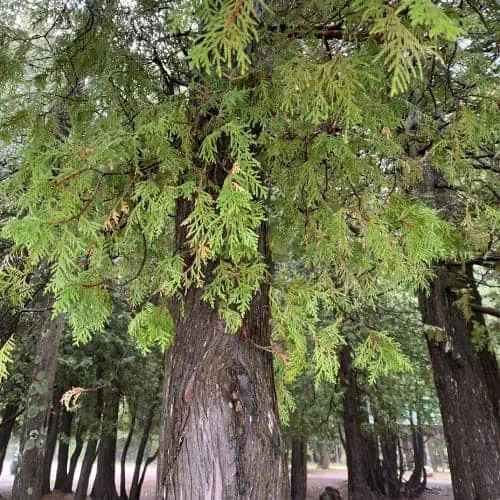
The northern white cedar is a stunning, shade-tolerant, and evergreen member of the cypress family (Cupressaceae). Due to its attractive features and ease of care, it is often cultivated as an ornamental tree in temperate zones. With a trunk growing to a maximum height of just 49 feet (15 meters) tall, it is considered a medium-sized tree. In areas where water and nutrients are scarce, its shoot may develop in a stunted manner.
The root system of northern white cedar is able to expand in moist, clay-based soils due to its naturally shallow nature. Individual roots tend to lengthen in a horizontal manner close to the soil surface, where they are less likely to suffer from anoxic conditions. This type of root system allows this species to colonize sloping areas and rocky cliffs, where water and nutrients may be trapped in crevices. It also helps stabilize the substrate along shorelines.
Due to its preference for wet soil, this tree may be referred to as the swamp white cedar. Its wood is durable and rot-resistant, making it highly prized as a type of lumber for home exteriors. Its highest productivity rates are observed in sites with rich organic content and access to clean streams.
5) Common hackberry (Celtis occidentalis)
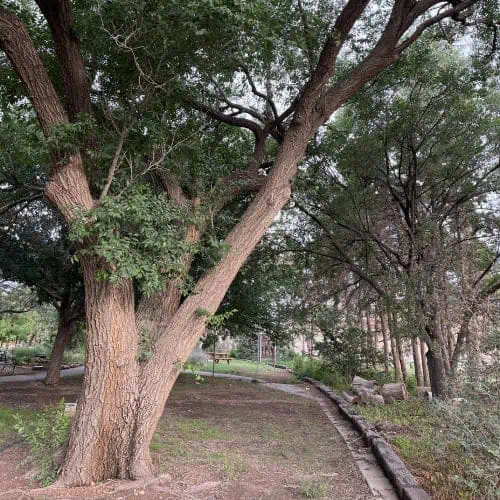
Although the common hackberry performs best in well-draining substrates, its mature specimens are able to tolerate conditions in gardens with a predominantly clay-based substrate. This is due to the variable nature of its root system. In dry areas, it can develop a strong taproot. In consistently moist areas, it produces a rapidly spreading and shallow root system instead.
If your garden’s substrates are slightly alkaline, you should definitely consider growing this tree. It can easily spread in consistently moist soils with pH levels of 6.0 – 8.0 or slightly higher in zones with full to partial sun exposure. When the roots are exposed to dry substrates, this tree may exhibit stress by dropping a fair amount of its leaves outside of fall or winter.
A long-lived and beneficial hardwood species, the common hackberry can be grown in stands to serve as a natural windbreaker along exposed highways. Its edible fruits are important for small mammals and many endemic birds throughout its native range. It is exceptional as a landscape tree because of its highly-textured bark and heavy canopy.
6) Green ash (Fraxinus pennsylvanica)
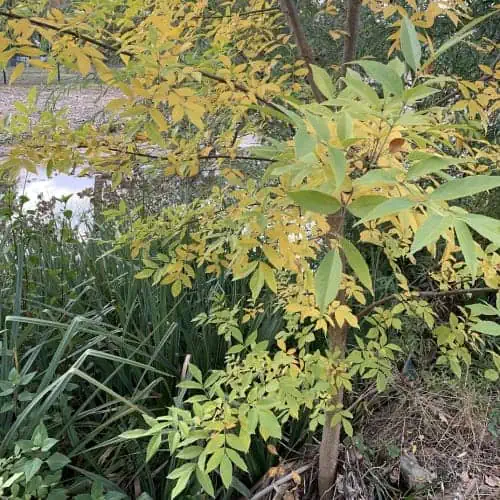
Like other ash trees of the Fraxinus genus, green ash favors moist to wet conditions in a wide range of substrate types. As it is frequently found growing along the edges of moist woodlands and along the banks of streams, it is also referred to as water ash. Among its congeners in the US, it has the most widespread distribution and is perhaps the fastest grower.
Green ash often forms mixed stands with other water-loving trees, such as those in the maple and willow families. Due to its rapid growth rate, it can be cultivated as a shade tree. On average, mature specimens may measure up to 80 feet (24 meters) tall and have trunks that are about 24 inches (61 cm) wide. Their compound leaves are composed of leaflets with distinctly serrated margins. Bright green, they become golden-yellow in fall.
Throughout its native range, green ash is an important food source for many animals in riparian zones. Even its fallen leaves can sustain the growth of juvenile fish, amphibians, and other detritivores in freshwater features. As the tree has minimal concentrations of tannins, both its leaves and branches are safer for amphibious herbivores and are less likely to discolor small bodies of water.
7) Red spruce (Picea rubens)

A tree that favors moist climates in cool, temperate zones, the red spruce is a perennial conifer with many uses. Though it thrives in well-draining substrates with a primarily sandy or loamy base, it is able to tolerate slightly clay-like and acidic soils. Its roots, which are usually shallow, fibrous, and finely branched, can subsist in low-nutrient conditions.
With wild stands found in the swampy areas of wetland forests, this hardy tree is an ideal choice for areas where other trees may struggle to become established due to excess moisture. It has a high tolerance for shade, so its seedlings can usually survive alongside larger trees. They can serve as an important part of the understory in mature forests because it takes them decades to reach their full size.
Note that, despite this species’ tolerance for wetland conditions, it is formally categorized as a facultative upland tree. This goes to show how hardy it is in the face of various conditions and how versatile it can be as an addition to landscapes with mixed substrates. Highly adaptable in the transitional zones between different biomes, it is an ecologically important species.
8) Northern catalpa (Catalpa speciosa)
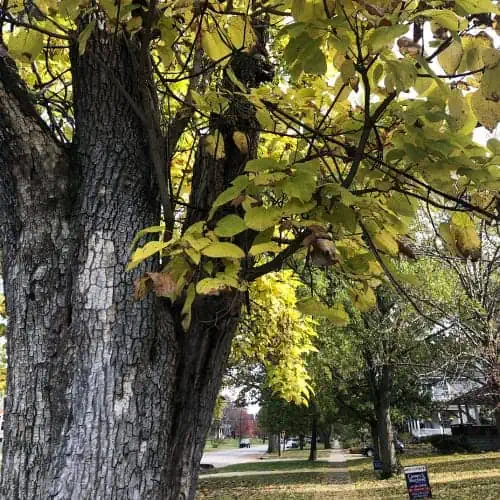
A showy tree with a knack for developing invasive roots, the northern catalpa favors moist to wet substrates. Able to grow extensively, its roots can rapidly inch toward sources of water, such as swimming pools and sewer lines. In some cases, they may be aggressive enough to infiltrate structures and cause significant damage. For this reason, this species should be planted at least 50 feet (15 meters) away from permanent water features.
As a plant for rain gardens with troublesome substrates, however, northern catalpa may be the right choice. Its tolerance for occasional floods and periodic droughts highlights its hardiness and versatility. It’s all too easy to underestimate this rapid grower! Apart from its capacity to produce new plants from stem fragments, it can spread quickly by self-seeding.
Some interesting attributes of the northern catalpa include large, heart-shaped leaves, a ridged bark, and eye-catching inflorescences of trumpet-shaped blooms. Able to grow practically anywhere throughout its native range, it is a recipient of the RHS Award of Garden Merit. To accentuate its attractive features, make sure to situate it under full sun.
9) Swamp white oak (Quercus bicolor)
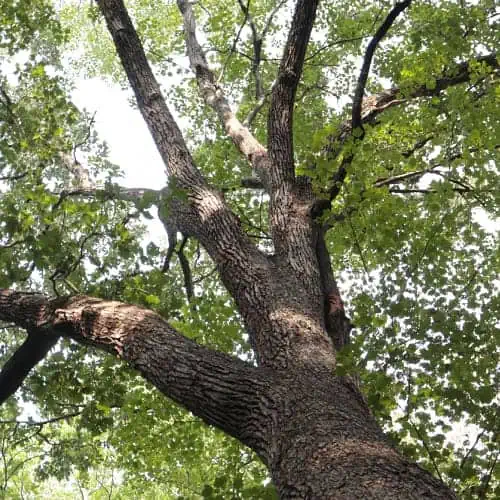
The swamp white oak is a medium-sized, lowland tree. Fairly long-lived and hardy, it can persist in a wide range of soil types and moisture levels. The tallest of its kind may measure as much as 95 feet (29 meters) tall and boast lifespans of two centuries or more. Distinguished by a furrowed bark and ovoid foliage, it resembles the white oak (Q. alba).
The swamp white oak is naturally found in moist woodlands alongside other water-loving maple, ash, elm, and oak trees. Its stands may occur along the margins of freshwater bodies, like lakes, ponds, and streams. Although its roots can tolerate occasional exposure to excess moisture, they may suffer under permanently flooded conditions. They can usually survive in heavy or clay-based soils with slightly acidic to slightly alkaline pH levels.
Though they prefer moist substrates, healthy swamp white oak trees may even survive through periodic droughts. Their best features are brought out by full sun exposure and frequent irrigation. As a tree that produces acorns, it is highly important to many birds and mammals. Its acorns drop in fall and may attract wildlife to your garden.
10) Black tupelo (Nyssa sylvatica)
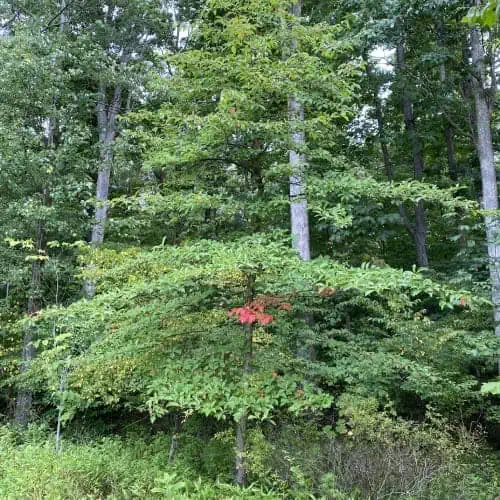
Commonly called black tupelo, sour gum, or black gum, N. sylvatica has a fairly extensive natural range. While it does have stands in upland areas, it is also found in bottom wetlands and coastal plains. Some of its healthiest specimens are rooted in clay-based and loamy substrates. Those that grow in dry substrates seldom produce large logs.
Often cultivated as an ornamental shade tree in private gardens, the black tupelo grows to a manageable height of about 80 feet (24 meters). Its young trunks tend to appear flaky, whereas its mature trunks are distinctly furrowed. Deciduous, its lustrous and wavy-edged leaves become purple to deep-red in fall. Its clusters of flowers, which attract many pollinators, arise at the tips of lengthy stalks.
In wet areas, the black tupelo usually develops a distinct taproot, from which a swollen trunk arises. The point at which the trunk begins to narrow is usually related to the water level. In permanently flooded habitats, such as deep swamps, the swamp tupelo (N. sylvatica var. biflora) can be quite dominant due to its tolerance for submersion.

